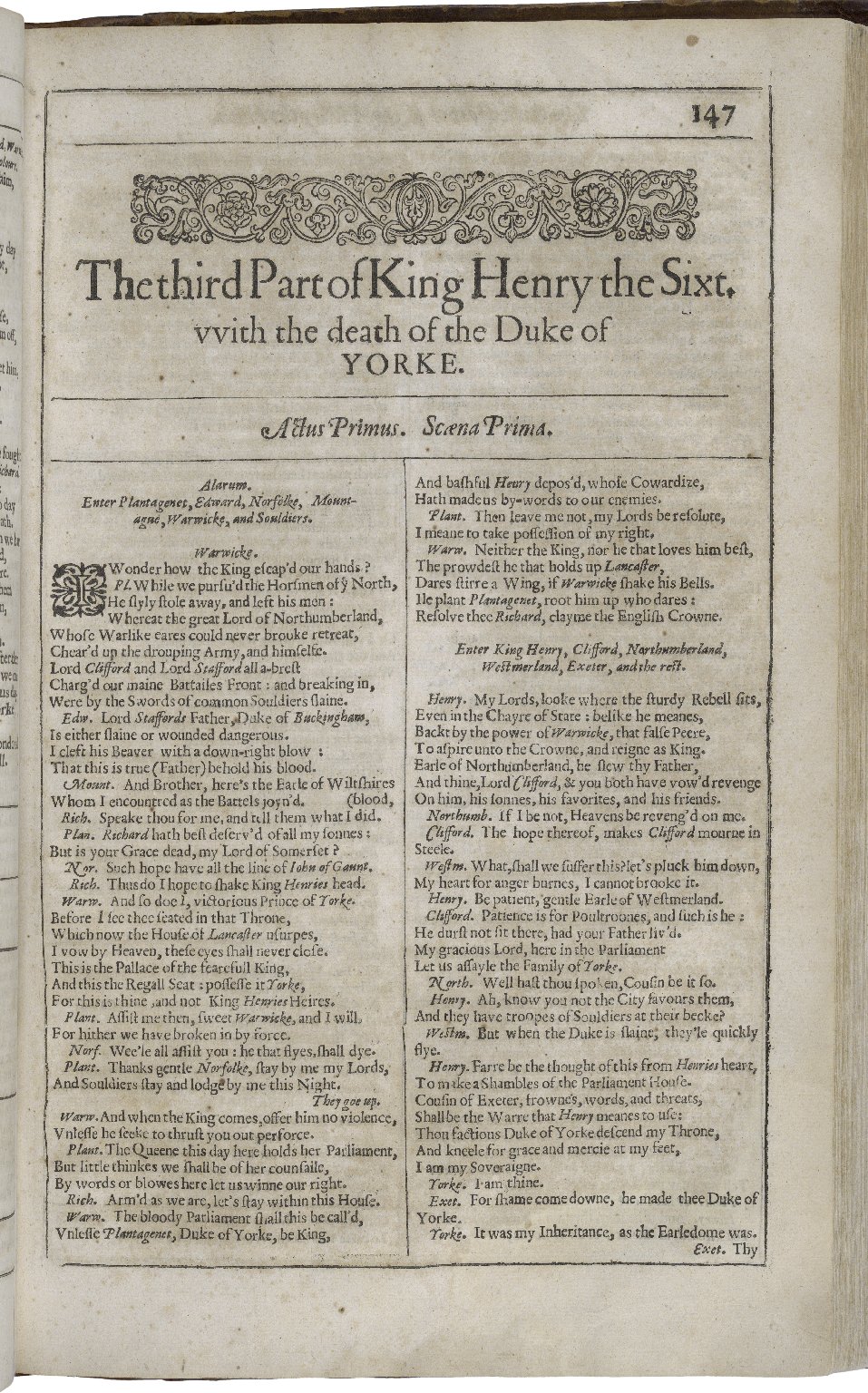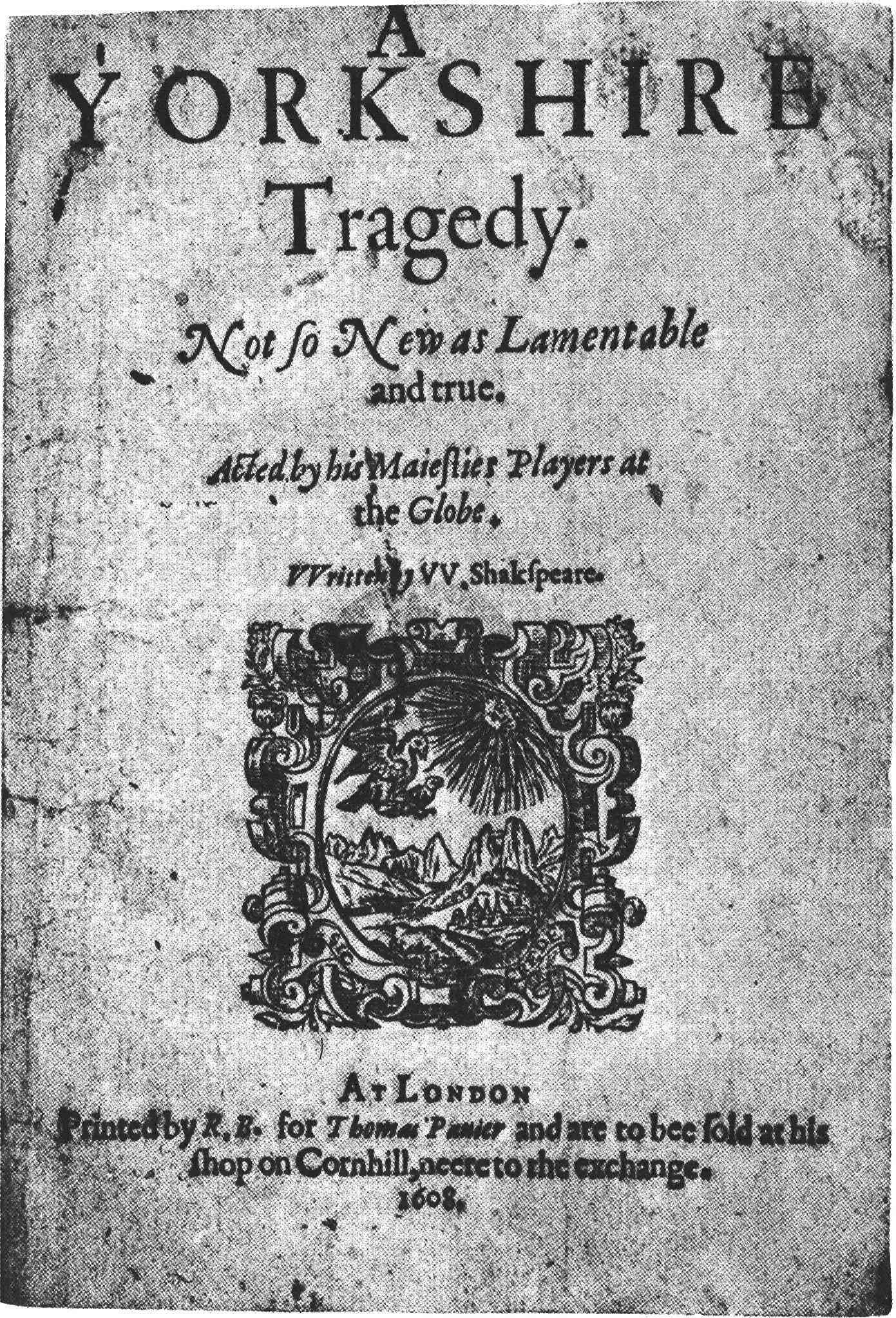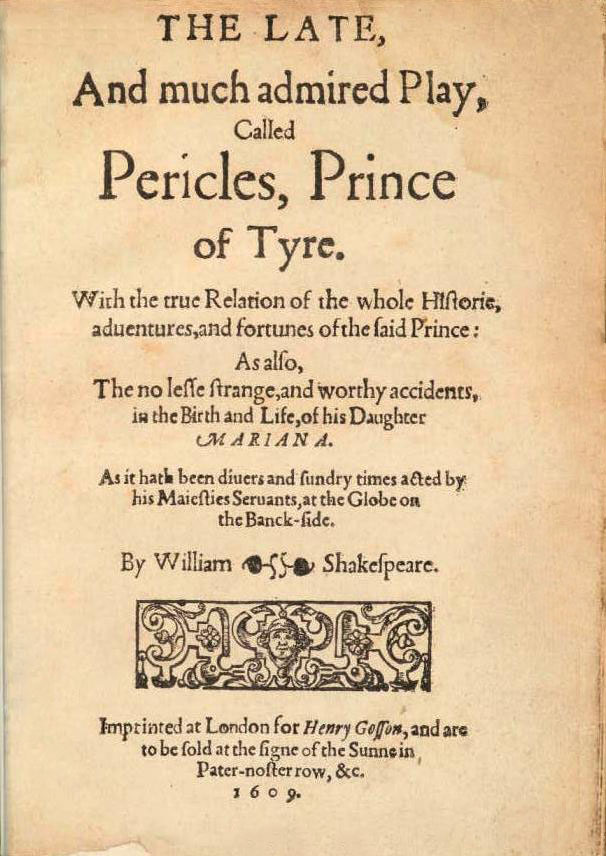|
False Folio
False Folio is the term that Shakespeare scholars and bibliographers have applied to William Jaggard's printing of ten Shakespearean and pseudo-Shakespearean plays together in 1619, the first attempt to collect Shakespeare's work in a single volume. There are only two complete extant copies. One is part of the collection of the Folger Shakespeare Library in Washington, DC. The other is held in the Special Collections at Texas Christian University in Fort Worth, Texas. The term "false folio" intentionally evokes the folio collections of Shakespeare's works that appeared later: the First Folio of 1623 and its three seventeenth-century successors. The description "folio" is not strictly accurate, since the ten plays were printed in a larger-than-usual quarto format, not in folio; but the key qualifier is ''false'' folio. The texts in question were first examined with modern bibliographic procedures primarily by Alfred W. Pollard, W. W. Greg, and William J. Neidig. Pollard provides ... [...More Info...] [...Related Items...] OR: [Wikipedia] [Google] [Baidu] |
King Lear
''King Lear'' is a tragedy written by William Shakespeare. It is based on the mythological Leir of Britain. King Lear, in preparation for his old age, divides his power and land between two of his daughters. He becomes destitute and insane and a proscribed crux of political machinations. The first known performance of any version of Shakespeare's play was on Saint Stephen's Day in 1606. The three extant publications from which modern editors derive their texts are the 1608 quarto (Q1) and the 1619 quarto (Q2, unofficial and based on Q1) and the 1623 First Folio. The quarto versions differ significantly from the folio version. The play was often revised after the English Restoration for audiences who disliked its dark and depressing tone, but since the 19th century Shakespeare's original play has been regarded as one of his supreme achievements. Both the title role and the supporting roles have been coveted by accomplished actors, and the play has been widely adapted. In his ' ... [...More Info...] [...Related Items...] OR: [Wikipedia] [Google] [Baidu] |
Stationers' Register
The Stationers' Register was a record book maintained by the Stationers' Company of London. The company is a trade guild given a royal charter in 1557 to regulate the various professions associated with the publishing industry, including printers, bookbinders, booksellers, and publishers in England. The Register itself allowed publishers to document their right to produce a particular printed work, and constituted an early form of copyright law. The company's charter gave it the right to seize illicit editions and bar the publication of unlicensed books. For the study of English literature of the later sixteenth and the seventeenth centuries—for the Elizabethan era, the Jacobean era, the Caroline era, and especially for English Renaissance theatre—the Stationers' Register is an crucial and essential resource: it provides factual information and hard data that is available nowhere else. Together with the records of the Master of the Revels (which relate to dramatic perform ... [...More Info...] [...Related Items...] OR: [Wikipedia] [Google] [Baidu] |
King's Men (playing Company)
The King's Men is the acting company to which William Shakespeare (1564–1616) belonged for most of his career. Formerly known as the Lord Chamberlain's Men during the reign of Queen Elizabeth I, they became the King's Men in 1603 when King James I ascended the throne and became the company's patron. The royal patent of 19 May 1603 which authorised the King's Men company named the following players, in this order: Lawrence Fletcher, William Shakespeare, Richard Burbage, Augustine Phillips, John Heminges, Henry Condell, William Sly, Robert Armin, Richard Cowley, "and the rest of their associates...." The nine cited by name became Grooms of the Chamber. On 15 March 1604, each of the nine men named in the patent was supplied with four and a half yards of red cloth for the coronation procession. Chronologically typed To 1610 In their first winter season, between December 1603 and February 1604 the company performed eight times at Court and eleven times in their second, from N ... [...More Info...] [...Related Items...] OR: [Wikipedia] [Google] [Baidu] |
The Passionate Pilgrim
''The Passionate Pilgrim'' (1599) is an anthology of 20 poems collected and published by William Jaggard that were attributed to " W. Shakespeare" on the title page, only five of which are considered authentically Shakespearean. These are two sonnets, later to be published in the 1609 collection of '' Shakespeare's Sonnets'', and three poems extracted from the play '' Love's Labour's Lost''. Internal and external evidence contradicts the title page's attribution to Shakespeare. Five were attributed to other poets during his lifetime, and two were published in other collections anonymously. While most critics disqualify the rest as not Shakespearean on stylistic grounds, stylometric analysis by Ward Elliott and Robert Valenza put two blocks of the poems (4, 6, 7 and 9, and 10, 12, 13 and 15) within Shakespeare's stylistic boundaries. Jaggard later published an augmented edition with poems he knew to be by Thomas Heywood. Textual history ''The Passionate Pilgrim'' was first publ ... [...More Info...] [...Related Items...] OR: [Wikipedia] [Google] [Baidu] |
Signature Mark
A signature mark, in traditional bookbinding, is a letter, number or combination of either or both, which is printed at the bottom of the first page, or leaf, of a section. (The section is itself often known as a "signature", although technically this usage is incorrect.) The aim is to ensure that the binder can order the pages and sections in the correct order. Often the letters of the Latin alphabet have been used. The practice has been overtaken by advances in printing technology, and signature marks are rarely found in modern books. Contemporary use of signature marks A number of symbols traditionally used as binding signature marks were encoded in ISO 5426-21996, Information and documentation -- Extension of the Latin alphabet coded character set for bibliographic information interchange -- Part 2: Latin characters used in minor European languages and obsolete typography and from there (to enable migration of data from the old standard) were transposed into Unicode. * 0x32 ... [...More Info...] [...Related Items...] OR: [Wikipedia] [Google] [Baidu] |
Henry VI, Part 3
''Henry VI, Part 3'' (often written as ''3 Henry VI'') is a history play by William Shakespeare believed to have been written in 1591 and set during the lifetime of King Henry VI of England. Whereas '' 1 Henry VI'' deals with the loss of England's French territories and the political machinations leading up to the Wars of the Roses and '' 2 Henry VI'' focuses on the King's inability to quell the bickering of his nobles, and the inevitability of armed conflict, ''3 Henry VI'' deals primarily with the horrors of that conflict, with the once stable nation thrown into chaos and barbarism as families break down and moral codes are subverted in the pursuit of revenge and power. Although the ''Henry VI'' trilogy may not have been written in chronological order, the three plays are often grouped together with ''Richard III'' to form a tetralogy covering the entire Wars of the Roses saga, from the death of Henry V in 1422 to the rise to power of Henry VII in 1485. It was the succes ... [...More Info...] [...Related Items...] OR: [Wikipedia] [Google] [Baidu] |
Thomas Millington (publisher)
Thomas Millington ( fl. 1591–1603) was a London publisher of the Elizabethan era, who published first editions of three Shakespearean plays. He has been called a "stationer of dubious reputation" who was connected with some of the "bad quartos" and questionable texts of Shakespearean bibliography. Life and work He was the son of a William Millington, a "husbandman" of Hamptongay, Oxfordshire, and was apprenticed to a Henry Carre for a period of eight years, beginning on St. Bartholomew's Day (24 August) in 1583. Thomas Millington became a "freeman" (full member) of the Stationers Company on 8 November 1591. For a time he was in partnership with fellow guild member Edward White; their shop was located, and their title pages specify, "at the little north door of Paul's at the sign of the Gun." Millington's business was at the lower end of the publishing scale in Elizabethan England; he printed many ballads, including some by Thomas Deloney. In 1595 he published ''The Nor ... [...More Info...] [...Related Items...] OR: [Wikipedia] [Google] [Baidu] |
Henry VI, Part 2
''Henry VI, Part 2'' (often written as ''2 Henry VI'') is a Shakespearean history, history play by William Shakespeare believed to have been written in 1591 and set during the lifetime of King Henry VI of England. Whereas ''Henry VI, Part 1'' deals primarily with the Hundred Years' War#French victory: 1429–1453, loss of England's French territories and the political machinations leading up to the Wars of the Roses, and ''Henry VI, Part 3'' deals with the horrors of that conflict, ''2 Henry VI'' focuses on the King's inability to quell the bickering of his nobles, the death of his trusted adviser Humphrey, Duke of Gloucester, the rise of the Richard of York, 3rd Duke of York, Duke of York and the inevitability of armed conflict. As such, the play culminates with the opening battle of the War, the First Battle of St Albans (1455). Although the ''Henry VI'' trilogy may not have been written in chronological order, the three plays are often grouped together with Richard III (play ... [...More Info...] [...Related Items...] OR: [Wikipedia] [Google] [Baidu] |
A Yorkshire Tragedy
''A Yorkshire Tragedy'' is an early Jacobean era stage play, a domestic tragedy printed in 1608. The play was originally assigned to William Shakespeare, though the modern critical consensus rejects this attribution, favouring Thomas Middleton. Date and text ''A Yorkshire Tragedy'' was entered into the Stationers' Register on 2 May 1608; the entry assigns the play to "Wylliam Shakespere." The play was published soon after, in a quarto issued by bookseller Thomas Pavier, who had published ''Sir John Oldcastle,'' another play of the Shakespeare Apocrypha, in 1600. The play was reprinted in 1619, as part of William Jaggard's False Folio. It was next reprinted in 1664, when Philip Chetwinde included it among the seven plays he added to the second impression of the Shakespeare Third Folio. Form and genre The play is unusual in consisting of only ten scenes. The original printed text of the play identifies it as "ALL'S ONE. OR, One of the foure Plaies in one, called a York-Shire T ... [...More Info...] [...Related Items...] OR: [Wikipedia] [Google] [Baidu] |
Sir John Oldcastle
''Sir John Oldcastle'' is an Elizabethan play about John Oldcastle, a controversial 14th-/15th-century rebel and Lollard who was seen by some of Shakespeare's contemporaries as a proto-Protestant martyr. Publication The play was originally published anonymously in 1600 (Q1), printed by Valentine Simmes for the bookseller Thomas Pavier. In 1619, a new edition (Q2) carried an attribution to William Shakespeare. The diary of Philip Henslowe records that the play was written by Anthony Munday, Michael Drayton, Richard Hathwaye and Robert Wilson. (An entry in Henslowe's Diary records a later payment to Drayton for a second part to the play, which has not survived; because of this fact, the extant play has sometimes been called ''Sir John Oldcastle, Part I'' or ''1 Sir John Oldcastle''.) In 1664, the play was one of the seven dramas added to the second impression of the Shakespeare Third Folio by publisher Philip Chetwinde. Historical figure Like other subjects of Elizabethan h ... [...More Info...] [...Related Items...] OR: [Wikipedia] [Google] [Baidu] |
Pericles, Prince Of Tyre
''Pericles, Prince of Tyre'' is a Jacobean play written at least in part by William Shakespeare and included in modern editions of his collected works despite questions over its authorship, as it was not included in the First Folio. It was published in 1609 as a quarto, was not included in Shakespeare's collections of works until the third folio, and the main inspiration for the play was Gower's ''Confessio Amantis''. Various arguments support the theory that Shakespeare was the sole author of the play, notably in DelVecchio and Hammond's Cambridge edition of the play, but modern editors generally agree that Shakespeare was responsible for almost exactly half the play — 827 lines — the main portion after scene 9 that follows the story of Pericles and Marina. Modern textual studies suggest that the first two acts, 835 lines detailing the many voyages of Pericles, were written by a collaborator, who may well have been the victualler, panderer, dramatist and pamphleteer Geo ... [...More Info...] [...Related Items...] OR: [Wikipedia] [Google] [Baidu] |
A Midsummer Night's Dream
''A Midsummer Night's Dream'' is a comedy written by William Shakespeare 1595 or 1596. The play is set in Athens, and consists of several subplots that revolve around the marriage of Theseus and Hippolyta. One subplot involves a conflict among four Athenian lovers. Another follows a group of six amateur actors rehearsing the play which they are to perform before the wedding. Both groups find themselves in a forest inhabited by fairies who manipulate the humans and are engaged in their own domestic intrigue. The play is one of Shakespeare's most popular and is widely performed. Characters * Theseus—Duke of Athens * Hippolyta—Queen of the Amazons * Egeus—father of Hermia * Hermia—daughter of Egeus, in love with Lysander * Lysander—in love with Hermia * Demetrius—suitor to Hermia * Helena—in love with Demetrius * Philostrate—Master of the Revels * Peter Quince—a carpenter * Nick Bottom—a weaver * Francis Flute—a bellows-mender * Tom Snout—a tinker * ... [...More Info...] [...Related Items...] OR: [Wikipedia] [Google] [Baidu] |






